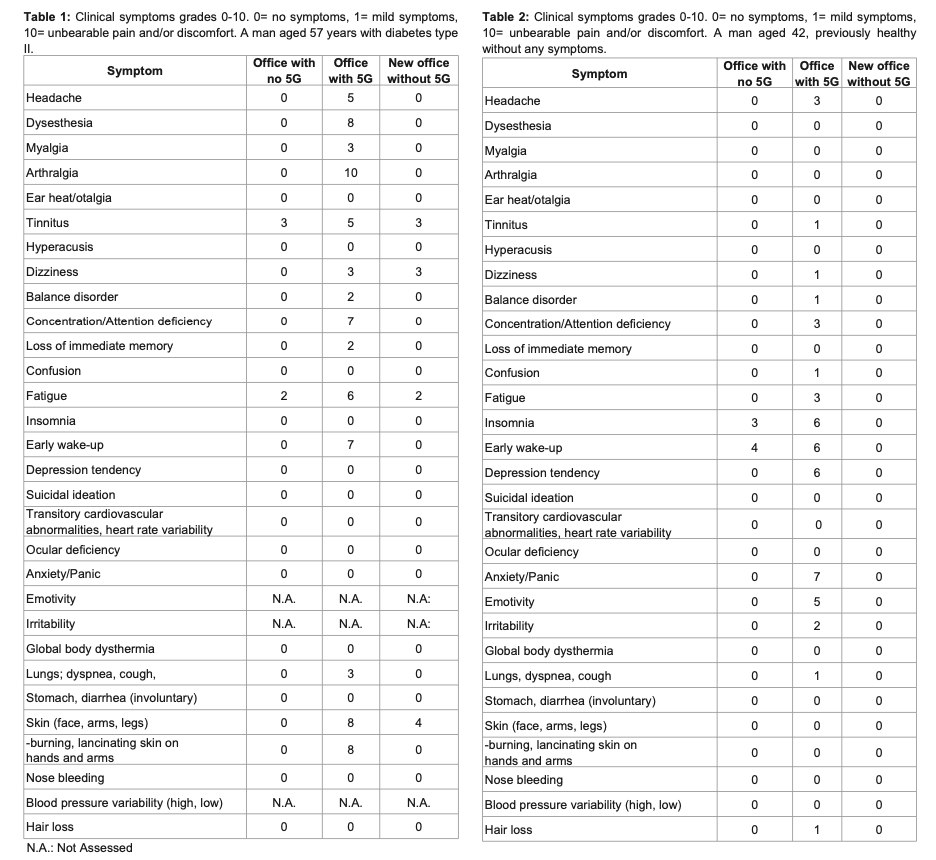People are now waking up to the harmful effects of EMF radiation in large numbers with the limited roll-out of 5G being a massive wake up call for those unlucky enough to be near a transmitter with any amount of sensitivity getting an ice-bath wake-up call.
The following article is taken from a Swedish study of two men working in an office that recently had 5G installed on the roof. It is eye-opening. Take a look at the table of symptoms at the bottom of the page.
As the world eagerly embraces the era of 5G technology, concerns about its potential health effects have arisen. In a groundbreaking case study published in the Annals of Clinical Case Reports, researchers shed light on the development of the Microwave Syndrome in two men shortly after the installation of a 5G base station on the roof above their office. This study not only underscores the urgent need for further research into the health impacts of 5G but also challenges existing guidelines for exposure to radiofrequency radiation (RFR).
The advent of 5G wireless communication heralds a new era of connectivity, promising lightning-fast internet speeds and unprecedented connectivity. However, the deployment of this technology has outpaced comprehensive studies on its potential health effects, leaving many questions unanswered.
5G – a Case Study
In this case study, researchers from the Swedish Radiation Protection Foundation and the Environment and Cancer Research Foundation describe the experiences of two men, referred to as Case 1 and Case 2, who worked in an office located close to newly installed 5G base stations. Shortly after the deployment of 5G, both men began experiencing symptoms typical of Microwave Syndrome, including headaches, tinnitus, dizziness, balance disorders, and fatigue.
The study revealed alarming levels of radiofrequency radiation (RFR) in the office environment, with peak exposures reaching as high as 1,180,000 μW/m2. These levels far exceeded the guidelines recommended by organizations such as the International Commission on Non-Ionizing Radiation Protection (ICNIRP) and the Federal Communications Commission (FCC), which are primarily based on thermal effects.
Non-thermal effects
What sets this study apart is its focus on non-thermal effects of RFR exposure, which have long been overlooked by existing guidelines. Symptoms of Microwave Syndrome, also known as Electromagnetic Hypersensitivity (EHS), manifest at exposure levels well below the established safety thresholds. The study highlights the inadequacy of current guidelines in protecting against these non-thermal effects, which include insomnia, heart palpitations, neurological symptoms, and skin disorders.
The experiences of Case 1 and Case 2 serve as a stark reminder of the potential health risks associated with 5G technology. Both men reported a significant alleviation of symptoms upon leaving the office environment and relocating to areas with lower RFR exposure. These findings suggest a clear link between 5G deployment and the onset of Microwave Syndrome, reinforcing the need for precautionary measures in the rollout of this technology.
Furthermore, the study challenges the assumption that 5G technology is safe based solely on thermal effects. While existing guidelines focus on preventing tissue heating, they fail to account for the myriad non-thermal effects observed in studies on RFR exposure. This gap in understanding poses a significant risk to public health, particularly as 5G technology becomes more ubiquitous.
Inadequate regulations?
The study also raises questions about the adequacy of current regulatory frameworks in addressing the potential health impacts of 5G. With 5G deployment accelerating globally, there is an urgent need for updated guidelines that consider both thermal and non-thermal effects of RFR exposure. The discrepancies between observed health outcomes and existing safety thresholds underscore the importance of evidence-based policymaking in the realm of telecommunications.
In conclusion, the case study on Microwave Syndrome in relation to 5G deployment highlights the need for further research into the health effects of this emerging technology. As 5G networks continue to expand, it is imperative that policymakers, regulators, and industry stakeholders prioritize public health and safety. Only through rigorous scientific inquiry and evidence-based decision-making can we ensure the responsible and sustainable implementation of 5G technology for the benefit of society.
Symptom table
Sourced from article “Development of the Microwave Syndrome in Two Men Shortly after Installation of 5G on the Roof above their Office (anncaserep.com) by:
Nilsson M1 and Hardell L2*
1Swedish Radiation Protection Foundation, Sweden
2The Environment and Cancer Research Foundation, Sweden


 David
David